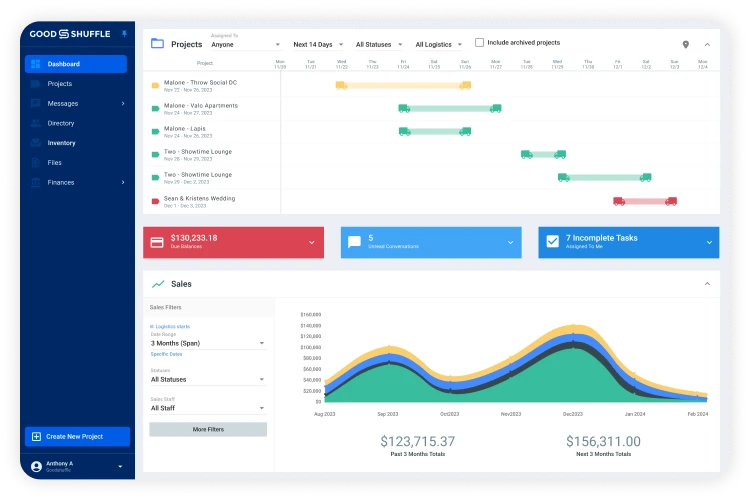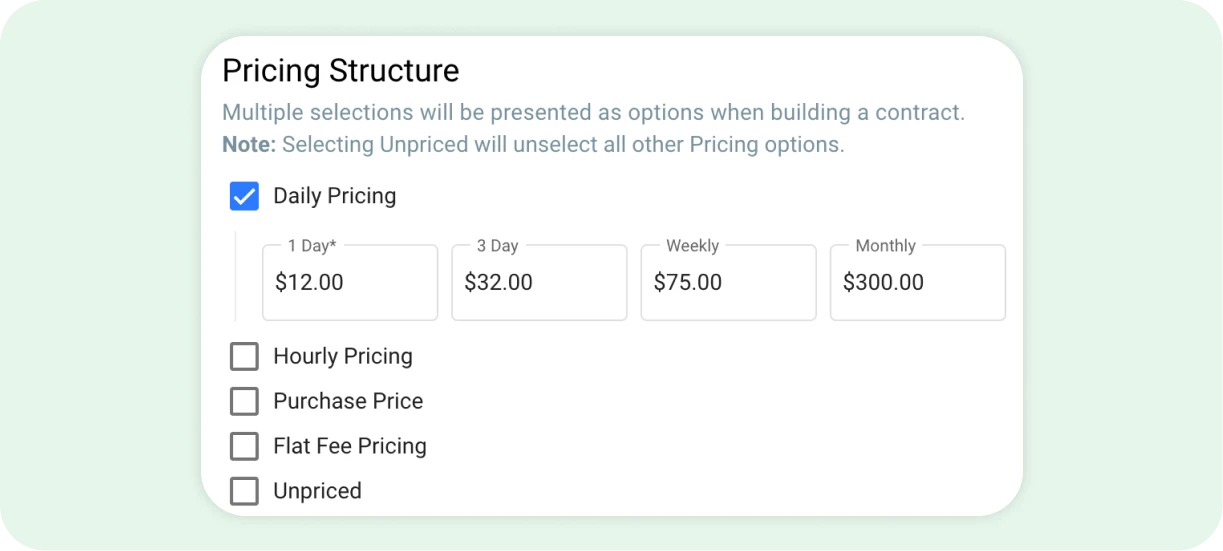Maybe you’re just getting started with your party rental business and don’t know the best way to price your items. Or maybe you’re an industry veteran and the time has come to reevaluate your pricing strategy.
Either way, event pricing strategy is an often overlooked and oversimplified aspect of running a profitable event or party rental business.
Let’s go over the basics of how pricing impacts your company’s positioning in the market, how to price rental items, and how to go about upselling and delivery.
Event Rental Pricing Strategy: How to Find the Sweet Spot

When you design your prices, what you’re really doing is answering a series of questions: What kind of customers do you want to target? What is the relative quality of your products versus the market? How much value do you believe your customers get from your products?
Your event rental company’s prices serve as a signal on your company’s position in the market. Low prices tend to attract a high volume of customers, but with low profits per event. High prices will attract fewer customers, but those events will be more profitable. It will inevitably require some trial and error to figure out the Goldilocks zone for your event rental company’s prices.
There are essentially two ways to determine your prices, which we’ll go over now. We recommend using both to find your ideal pricing.
The inward method: Cost-plus margin
The first method, what we’ll call the “inward method,” involves calculating your costs and desired profits to determine your prices. The advantages of this method are:
You get oversight of your costs
The inward method will tell you exactly how much you need to charge to run a profitable party rental business. You begin by calculating your break-even point, by adding up all of your costs of ownership. This will include purchase prices for equipment, operating costs, repairs, insurance, storage, depreciation, and more.
You can control your profitability
Once you’ve calculated your break-even point, you can then set your desired profits and set a total revenue goal. For instance, if your break even point is $20,000, and your desired profits are $40,000, then you will need to bring in $60,000 dollars of revenue.
You can then mold your prices around this goal. Let’s say, for simplicity’s sake, that you only have 10 inventory items. They’re all the same type of item, and you’d like to rent each of them out for $60 per day. You’d have to rent each item out 100 times to meet your goal of $60,000.
On the other hand, you could also rent them each for $100, in which case, you only have to rent them out for 60 days each.
The outward method: Mapping the market
The second method, or the “outward method,” involves researching the market and choosing your prices based on where you want to position your company.
After all, prices don’t just determine your profits. They also determine who your customers will be, where your company is positioned in the market, and how you will compete with other party rental companies or wholesalers.
If you want to consider your competition in your pricing decision — which you should — you’ll need to do some market research.
Perks of this method include:
You’ll understand your competitors
You’ll create a map of your direct competitors in the market. You’ll ask questions like: Which companies serve as premium options in the market? How do other companies choose to compete with them? Are there any standard practices that you need to take note of?
This practice will deepen your understanding of the competitive landscape, and allow you to identify gaps and opportunities.
Learn more about how to find your unique value proposition here.
For instance, you may notice that you can undercut a direct competitor’s list prices while providing similar value in your rentals and service. Or you may notice that very few of your direct competitors can match the level of service that you provide, so you decide to charge just a bit more than they do.
You’ll stay on top of industry trends
By monitoring market trends, your pricing will be more in line with current industry patterns. You may learn that you can charge more for inflatables during the summer months, for example. From there, you can establish your role in the market to best emphasize your competitive advantage.
Here’s one event design business’s secret to turning passion into profit.
Choose a Pricing Method
When pricing party rental items, you have a couple options to choose from. We recommend advertising a fixed pricing model, and giving flexible options only when necessary — it keeps things simpler.
Fixed pricing
When you price per day, per week, or per month, it’s a simple way to understand exactly how much projected revenue to anticipate. With a bit of usage data, you can get an income estimate that helps you plan your business investments and operations.
Flexible pricing
For short-term or more unique rentals, you may choose to price flexibly, or by the hour. If customers want to minimize expenses or only need items for a few hours, this might make the most sense for your business.
Learn more about five fees your event business should charge.
How to Price Party Rental Items

Pricing party and event rental items can be difficult, whether you’re new to the industry or an events veteran. We’ve put together a list of general best practices for some common event rental items to help you out.
Keep in mind that prices will vary based on the market, seasonality, and what’s trending. Many of these recommendations come from events expert Tom Friedman, from Got You Covered. You can click here to watch his full interview with EventStable.
Here’s an idea of how to price your basic inventory items (excluding delivery and set up):
| Furniture Type | Low-End Cost | High-End Cost |
| Plastic Folding Chairs | $1.50 each | $3.00 each |
| Chiavari Chairs | $5.00 each | $6.00 each |
| Round Tables | $8.00 per table | $12.00 per table |
| Rectangular Tables | $10.00 per table | $15.00 per table |
| Sashes | $2.00 per sash | $3.00 per sash |
| Tablecloths | $5.00 per tablecloth | $20.00 per tablecloth |
How to price plastic and resin folding chairs
A decent rule of thumb for plastic folding chairs and resin folding chairs is to rent them out for 10% of the purchase price. They don’t require much maintenance, and they take up a relatively low amount of storage space. That being said, be sure to monitor the market, as it may drive the price higher or lower over time.
How to price wood folding chairs
Wood folding chairs are similar to resin and plastic folding chairs, but they require more touch ups and maintenance, and may not last as long. This means a slight bump up from other folding chairs to about 15% of the original purchase price.
How to price folding tables
Folding tables usually provide a decent return on investment since they tend to last a long time and don’t require much maintenance. It is fair to charge 8-15% of the purchase price depending on the market.
How to price stacking chairs
Stacking chairs include chiavari chairs, crossback chairs, and other stackable chairs. Prices will vary over time as they go in and out of time. You can generally rent these out for slightly more than folding chairs (10-15% of the purchase price), as they will take more time to set up and break down, and take up more space in your storage space and delivery vehicle.
How to price flatware
Flatware requires a relatively large amount of labor, as they need to be manually counted, polished, sanitized, bagged, and counted again when they go out for rentals. A single plate may take as much time to clean as an 8-foot table, and this time cost needs to be accounted for. Rent for 30-40% of the purchase price.
How to price glassware
Breakage is extremely high for glassware, meaning you will have to replace them often. Crates for glassware can also be more expensive than the glassware they hold, and you don’t receive income for that crate taking up space in your storage. This calls for a rental rate of 30-40% of your purchasing price.
How to price chinaware
You can also charge 30-40% of your purchase price for chinaware, although you should charge slightly lower for chinaware than glassware. Chinaware does not experience as much breakage as glassware, and they require cheaper crates or no crates whatsoever.
How to price tablecloths
If you rent out tablecloths, you need to be prepared to replace them often, as stains and tears occur very regularly. You may only get 3-4 rentals out of each linen depending on the quality of your laundry service. On top of that, certain prints and colors tend to go in and out of style quickly, so demand will vary. Rent out tablecloths at 100-150% of the purchase price.
How to price catering equipment
Catering equipment is a broad category, and it’s near impossible to come up with a standard rule for some catering items. Chafing dishes can be rented out at 100% of their purchase price, as they are cheap, but may not last you very long.
Bigger equipment is more complex. Large catering equipment may require a truck and a lift gate, as well as several workers to deliver. Some items also require complementary items that need to be incorporated into the price. For instance, convection ovens require propane to be useful. They also take up a lot of space and can be expensive to purchase. Fortunately, these large catering equipment items will last you a long time, so buy a quality product if you see yourself using it multiple times.
You will have to do your own calculation based on your specific costs for these items.
How to price patio heaters
Patio heaters will require regular maintenance, so you can charge as much as 50% of the purchase price. You may also want to consider buying a less expensive patio heater for your rentals. Although it won’t last as long as a more expensive patio heater, a new patio heater will look nicer to your customers anyways, so replacing them often will pay off in that sense.
How to price dance floors
Dance floor will last you around 10-15 years, which is a long time. The downside, however, is that they require regular maintenance and a large amount of time and labor between installation, breakdown, and sanitization. A good rule of thumb is to charge 30% of the purchase price.
How to price staging
Staging can be very labor intensive, especially for more complex stages that contain a lot of components such as cross bracing and railings. Charge 30-40% of the purchase price for staging, depending on the complexity of installation.
How to price tents
Tents require a large amount of labor, insurance, and other costs. That being said, including tents in your inventory opens up your business to booking entire events, as people may prefer to just deal with one company for their tented events.
Charge 20-25% of your purchase price, not including delivery. You can mark up depending on trends, permits, and complexity, and charge extra for sidewalls and other additions.
Keep in mind that the poles and other equipment for tents may not fit in the same kinds of delivery vehicles you use for your other equipment. Consider the costs involved before adding a tenting arm to your event rental business.
Here’s an idea of how to price your tents (excluding delivery and set up):
| Tent Size (ft) | Cost Range |
| 10×10 | $150 |
| 20×20 | $200 – $500 |
| 20×40 | $300 – $750 |
How to price for lighting
Here’s an idea of how to charge for wedding lighting (excluding delivery and set up):
| Lighting Type | Cost Range |
| Uplighting for the Entire Ballroom | $700-$2000 |
| Monogram Gobo Light | $400-$700 |
| Texture Lighting | $75-$100 per light fixture/pattern |
| Cake Spotlight | $30-$100 |
| Pipe & Drape | $10.00 – $25 per linear foot (10 ft sections) |
| Pin-spot Lighting | $25-$45 per light/table |
| Bistro Lighting | $3-5 per linear foot |
| Chandeliers | $225 – $500 each |
| Pendants | $15 – $25 each |
| Low Fog | $250 – $350 |
How to price for A/V services
Most A/V companies follow the 10% rule, meaning you charge 10% of whatever it costs to buy a piece of equipment. You’ll break even at around 10 events.
How to price event space
When deciding how to price an event space, you’ll need to understand your venue type, room size, party size, demand trends, and venue occupancy. If your venue is generally underbooked, you may want to charge the minimum needed to cover your expenses. A typical expense-based rental rate could look like the hourly cost of overhead expenses (rent, utilities, maintenance, insurance, and so on), plus 10%.
If your venue is usually fully booked, you can base your minimums on projected revenue, to maximize on high demand for, say, a Saturday night. But other considerations come into play as well, like if you’re operating a space-only rental or if you’re catering the event.
Pro Tip: You can always exercise options like Buy Now, Pay Later to overcome client “sticker shock.”
4 Common Mistakes When Pricing Party Rental Items
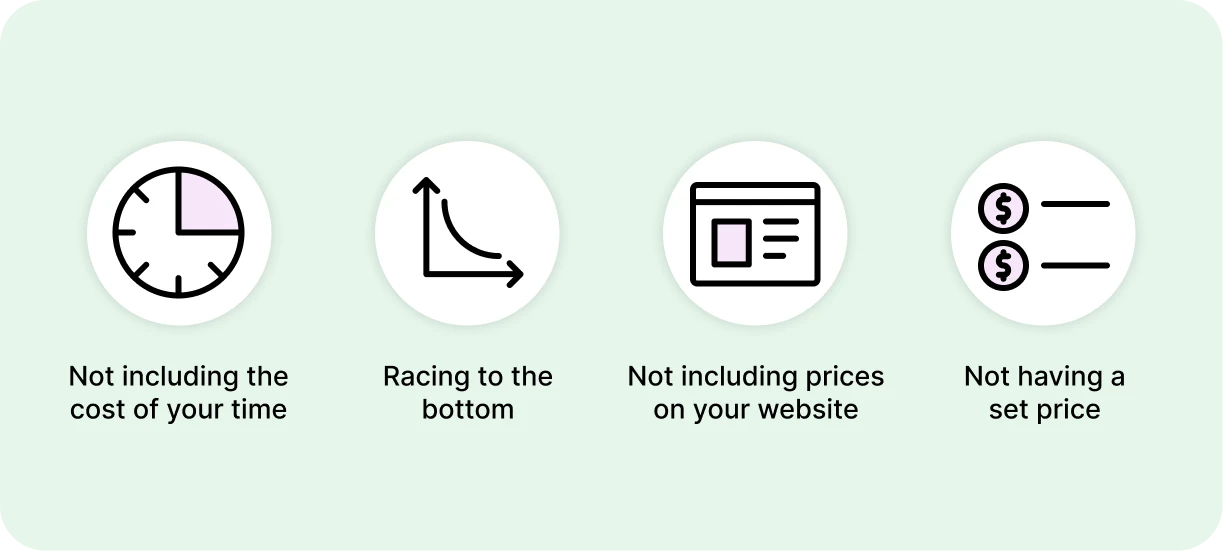
Now that you’re well on your way to a winning event pricing strategy, let’s take a look at he most common party rental pricing mistakes so that you don’t have to learn the hard way:
Not including the cost of your time
There’s one cost party rental companies always leave out: The cost of labor for themselves and their crew.
Don’t forget, you’re paying your crew during the time they’re delivering items to an event site, and loading and unloading those items. You might spend a few hours building a custom item. Where is all that money coming from?
If the cost of this time isn’t included in your price, you will eat significantly into your profits, or even lose money on the transaction.
Here are the things people often forget to include in event budgets.
Racing to the bottom
This may be the biggest and most common mistake, not only in the events industry, but for businesses across the board.
Here’s the problem with lowering your prices as much as possible: Lower prices inevitably lead to lower profits. You’ll have to work harder to serve more customers just to make the same profits as a business that charges higher prices.
This leads us to the second problem with this approach: There’s always someone who is willing to set lower prices. This race to the bottom will cut into your profits more and more as your costs remain the same, and your party rental business will eventually collapse when you become unable to offset your costs.
However, the biggest flaw to this strategy is in the long term. Prices communicate your perceived value to customers. Do you want customers that perceive you as a budget option, or ones that see you as a high-value service?
Here are three reasons higher prices can benefit your event business.
Not including prices on your website
Listing your prices can be complicated. Every event is different based on inventory items used, services requested, and any number of other factors.
But studies show that buyers are increasingly valuing transparency from brands, especially when it comes to pricing. According to WeddingPro Educator Alan Berg, “roughly 80% of couples find it very important to see pricing prior to reaching out to a wedding pro.”
We know that pricing for things like tents and A/V services won’t be one-size fits all. You can always add a disclaimer on your website that states something like, “Pricing varies based on project.” You can also add starting prices or ranges when listing numbers on your website.
The real problem with hiding your prices online is that you’re paying your sales team to spend most of their time trying to reel in prospects who never had the budget for your services to begin with. On top of that, a vague pricing system leaves room for prospects to negotiate on every nickel and dime.
The result? Your conversion rate is down the drain, and your profit margins are decreasing on each deal as well.
Check out our guide to hiring and paying salespeople.
Not having a set price
We know that every customer is different. But while some scenarios will call for an upcharge, and some clients will be eligible for discounts, the best approach in the long term is to stick to your baseline price in most situations.
A fluid price will erode trust between yourself and your customers, which will negatively impact the likelihood of gaining repeat business from loyal customers. This also leaves room for customers to negotiate your prices down, which will take away from your profits.
Instead, be confident in your prices. Turn down business opportunities for customers who can’t afford your prices and choose not to scam your valuable customers. Stick to your prices, and give your customers the confidence they need to stick with you.
How to Charge for Deliveries
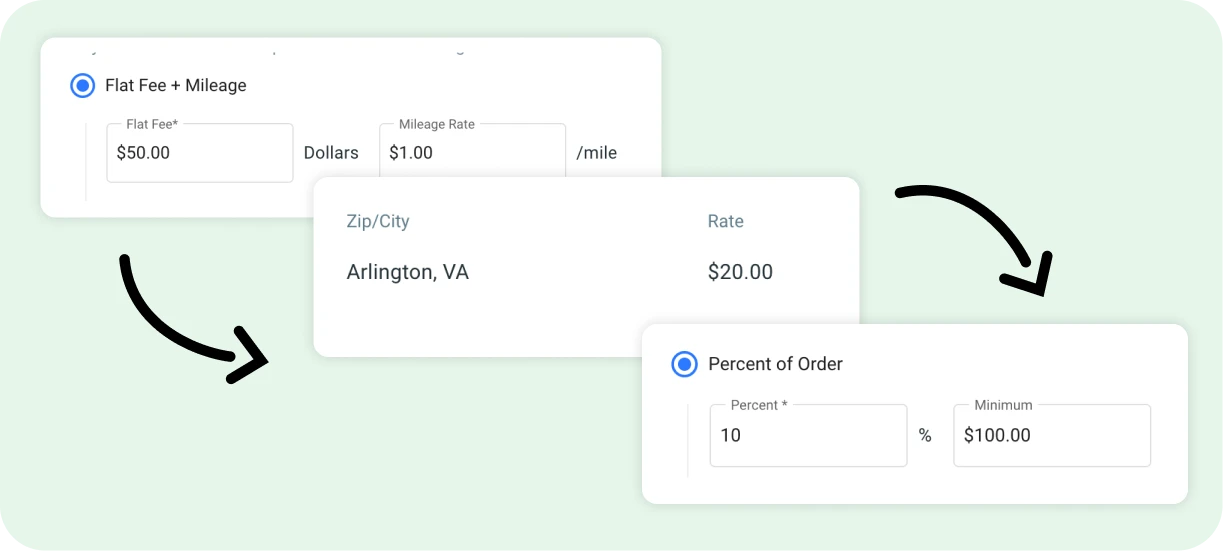
Delivery fees can be tricky. Since a delivery fee often can’t be calculated until after the rest of the order is finalized, it’s a common opportunity for customers to complain. This can be incredibly costly to your business in terms of disputes, reviews, and money if your delivery fee is an estimate without solid grounding to back it up.
To avoid these potential damages, it is best practice to set a standard for calculating your delivery rate and sending quotes. Here are the 3 most popular methods for calculating the charge for delivery for event rental professionals:
Flat fee plus mileage
In this pricing structure, total fee can be determined by the following formula:
Total Fee = Flat Fee + (Mileage Rate x Distance)
You can view the flat fee as a charge to rent the truck, and base it on 1) how many trucks you own, and 2) the estimated opportunity cost.
It’s up to you whether your crew’s hourly rate will be the same or less while traveling than their regular hourly rate. Your crew’s time should include transportation time as well as loading into the truck, unloading at the venue, reloading the truck, and unloading back at the warehouse.
The hourly fee for your crew should be the real rate of pay for these workers, not just their hourly rate. This will include their hourly rate plus any additional fees to come with compensating your employees, such as insurance costs, charge rush fees, benefits, taxes, payroll fees, and more.
You may need to talk to your accountant or bookkeeper to calculate an hourly average for each of these costs to find your real rate of pay. This may vary from worker to worker, and it is up to you whether to base your fee on your highest-paid worker or an average of all of your workers’ real rates of pay.
Flat fee per zip code
Charging a flat fee by zip code allows you to charge based on distance and traffic density for each area you deliver to. This ensures that the delivery fee will grow as the travel distance increases. This can also be useful as city deliveries may take longer than deliveries to less populated areas that are a similar distance from your warehouse, as your crew will likely have to sit in traffic for a while.
For instance, if delivery to Midtown Manhattan may take longer than delivery to a slightly closer area simply because of the heavy city traffic. In this case, charging based on mileage alone does not account for your cost of delivery. Setting a price based on zip code will ensure that you are properly compensated.
Goodshuffle Pro will automatically override delivery fees for these specific zip codes. This means you can charge for mileage, but make an exception for a city where you want to charge more due to traffic, or less because it’s a place you travel to often and easily.
Percentage of order
Another method would be to calculate your delivery fee as an additional percentage of the total order cost. This is a very simple method that may not account for your exact costs incurred during the delivery process (may be slightly higher or lower in different circumstances), but it will charge a larger amount for larger deliveries.
If you choose to use this method, be sure to include a minimum delivery fee. Small orders require less travel time and gas, but they do not take away from your workers’ hourly wages. This is important to ensure that you are properly compensated for your services.
Don’t Forget to Upsell
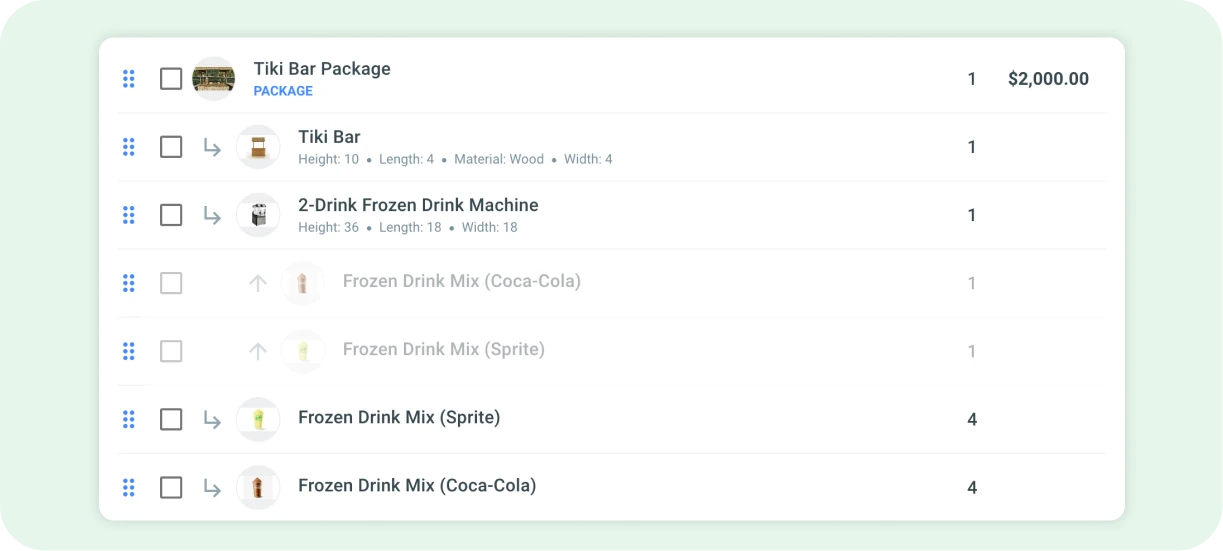
Wouldn’t it be nice if you could make 30% more on each event by upselling your clients? After all, event rentals are limited in the number of events they can host or manage based on time and inventory, making a few high volume orders much more appealing than several smaller orders.
You can make the same or even better profits with less time invested by focusing on the size of each deal rather than the quantity of deals. But how do you convince customers to submit larger orders?
Let’s take a look at some of the best opportunities for event rental businesses to upsell.
Packages
You see packages at work much more often than you may realize. Every time you order from your local fast food joint, they’ll ask if you want to purchase the full “meal” rather than just the single food item. Odds are you get the fries and drink with your burger just about every time.
Selling packages instead of individual inventory items is one of the most powerful upselling tools out there. Why have your customers browse through your inventory to pick out a few items when you can suggest a bundle of several items that complement each other?
This makes for an easier and more enjoyable buying experience for your customers, and allows you to sell them items that they may not have ever considered buying or renting before.
With Goodshuffle Pro’s Website Integration, your customers can shop your inventory 24/7.
Deals and discounts
Offering deals to promote certain products is an excellent way to increase the volume of your average order. This can help you move low-volume items, especially when there’s a limited-time component to the deal, like a 4th of July sale.
It also creates a sense of time pressure for your customers to try out more of your products while they can still take advantage of the deal. Customers who might not be willing to pay full price their first time renting the item will hopefully come back for more as well.
The only issue with this approach comes from overuse. Constantly offering discounts for low-volume items can depreciate their perceived value in the eyes of the customer. If you offer discounts too often, your customers may not be willing to pay the standard price for
the item when the deal ends. If you want to increase the rate that you move low volume items, we would recommend discounting them in a package.
Direct upselling
Upselling directly to your customer during a consultation or sales meeting requires a different approach. It demands some finessing and attention to detail, meaning that before you offer them anything, you need to listen and understand the situation.
When discussing the customer’s vision for their event, pay close attention to their goals and motivations. Knowing your client is the most important step in upselling directly. This will allow you to customize your suggestions to their needs. Are they trying to impress their boss? Are they on a tight budget? What is the tone of this event?
Most importantly, don’t try to convince them that it’s worth the additional cost. Make it clear that you’re on their team, and that you want their event to be as amazing as possible.
Leverage Party Rental Software in Pricing Your Party Rental Items
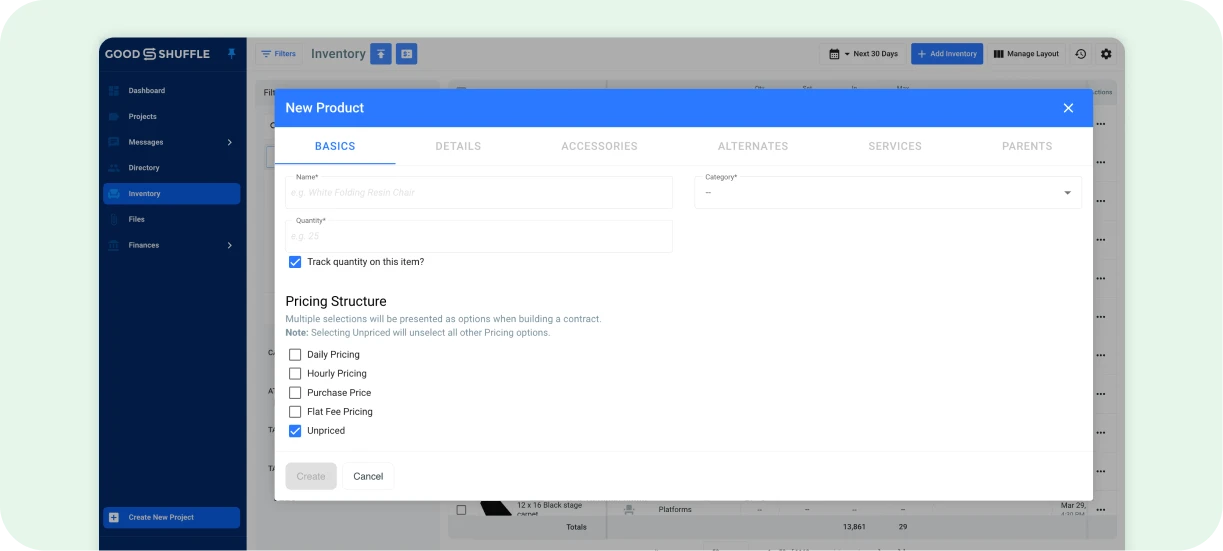
Now you’ve got a solid basis for your pricing strategy and know how to price party rental items. But why spend your limited time gathering data, making reports, and handling customer inquiries when you can let software do it for you?
Easy-to-read, customizable reports
Event rental pricing decisions require precise knowledge of revenues and inventory usage, and that’s exactly what you get with Goodshuffle Pro.
Goodshuffle Pro’s Financial Hub provides you with all of the information you need to make sound pricing decisions for your event rental business. Its clear, easy-to-understand reports and dashboards mean you’ll be able to plan around your profitable items, seasons, or events.
You can stay on top of when to purchase more inventory, when to push items that are being underutilized, and when to retire items that have run their course — so you’re not paying to store inventory that’s not earning its keep.
Inventory editing with a few clicks
While reports make it easier for you to learn about your inventory usage and plan price adjustments, Goodshuffle Pro’s Bulk Edits feature speeds up the process of actually editing your inventory.
If you have 500 different plastic chairs and want to double the price for all of them during the fall, you don’t have to update 500 records — you can do that in 20 seconds, then change it back in the winter just as quickly. It’s never been easier to manage inventory.
Flexible pricing options
Goodshuffle Pro also enables you to set individual pricing for daily rates, hourly rates, purchases, and flat fees.
The ability to price a package by the contents included will easily let you see the cost of the individual items — then you can make the decision if your clients get a deal for booking everything (or if they get discounts for larger package deals).
For instance, take a package with contents that could be individually rented out for $520, being bundled together and priced at $350 for a full day rental. Why give discounts on larger package deals like this? You’ll bring in more large events when you incentivize large event deals. At the same time, you’ll delight your customers, and maintain a strong and flexible pricing strategy.
Integrate inventory and pricing with your website
A good event rental software will not only integrate your inventory with your website but also allow you the freedom to present this information to your clients however you’d like.
Goodshuffle Pro’s Website Integration is the ultimate tool for turning your website visitors into paying customers. It allows potential clients to browse your inventory 24/7, quickly build a list of everything they desire for their next event, then send it off to you for approval.
Not only is it fun for clients to build their own orders with your inventory, but when they send in an inquiry, you can save time and energy building quotes. Even if a client isn’t sure exactly what they need from you, they can still submit their information to you and you can follow up to help them build out their perfect day.
And when you decide to change your prices in Goodshuffle Pro, the integration will instantly update them on your website for real-time accuracy — no action required on your part.
